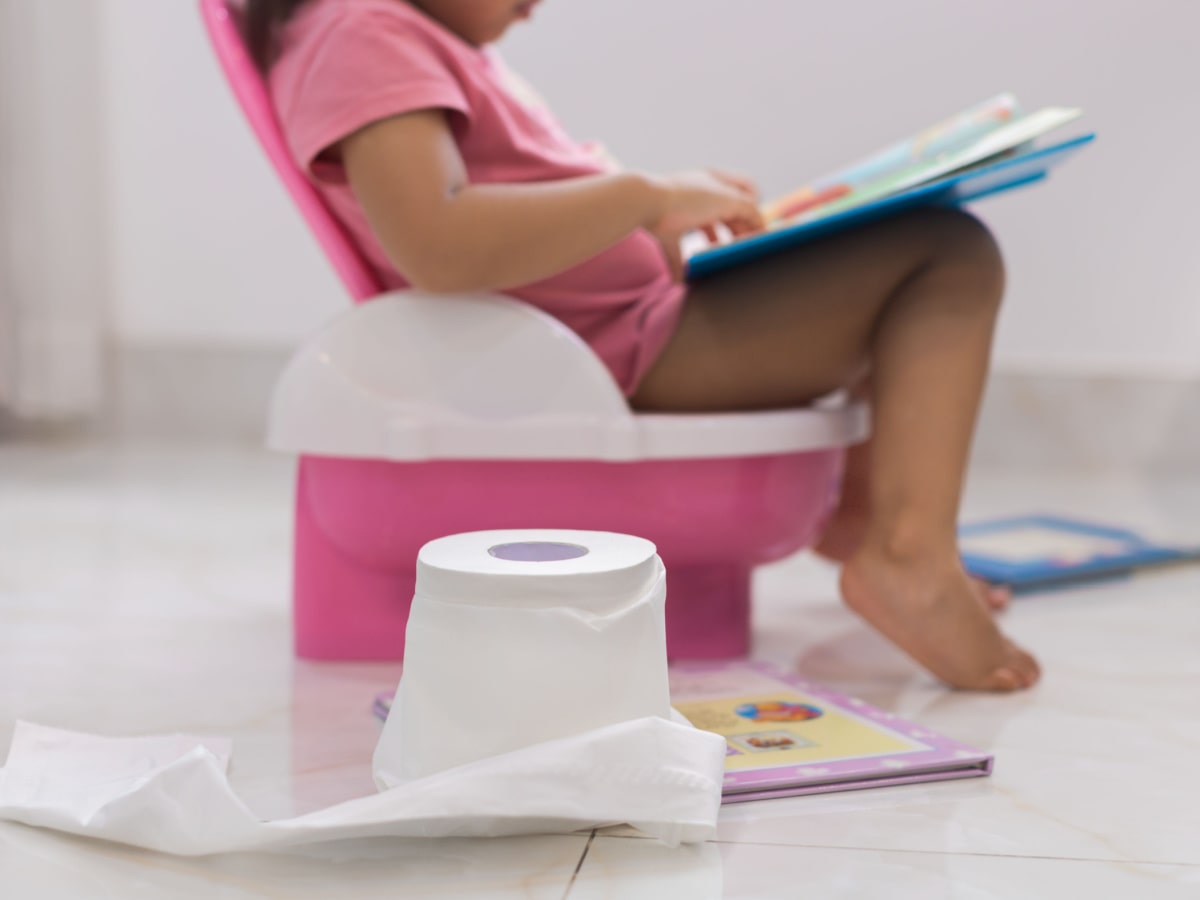
Children’s bowel patterns can vary depending on age, diet and toilet training. However, constipation can be a common issue in early life.
This may be short-lived or only present occasionally. Rather than stool softeners or laxatives being the only option, this article will discuss the possible cause of constipation, the symptoms and natural ways to resolve it.
What is constipation?
Constipation is typically described as trouble going to the toilet. This may be having to strain to pass a stool or missing several days between bowel movements.
It’s been reported that 3% of paediatrician visits and 30% of visits to a paediatric gastroenterologist are due to constipation.
The official criteria to assess for constipation is outlined in the ROME Criteria.
This outlines, that for a diagnosis of constipation, two or more of the following must be present:
- Two or fewer defecations per week
- At least one episode/week of incontinence after the acquisition of toileting skills
- History of excessive stool retention
- History of painful or hard bowel movements
- Presence of a large faecal masses in the rectum
- History of large diameter stools which may obstruct the toilet. [1]
A challenge can be that infants or children may not yet be talking and therefor unable to describe the symptoms they’re experiencing.
In other cases, constipation may have been present for a long time and they may not understand that this is causing discomfort.
What are the signs and symptoms of constipation in children?
In addition to the symptoms listed above further signs and symptoms may be present in children with constipation.
These can include:
- Bloating
- Abdominal distension
- Tummy ache
- Nervousness about going to the toilet (due to stools being hard and possibly painful)
It can often be the case that bloating or distention may be the sign that indicates a digestive issue.
There can also be accompanying signs and symptoms that resolve following a bowel movement.
These can include:
- Irritability
- Poor appetite
- Feeling full quickly after eating
What causes constipation in children?
As with adults, there is not a single factor that is known to lead to all cases of gut symptoms.
There are however a number of risk factors that increase the likelihood of developing constipation.
These include:
- Dehydration
- Sex (higher rates in females)
- Gut infections (gastroenteritis and food poisoning can increase the risk)
- Diet (low fibre in the diet can impact bowel movements)
- Food allergies (these increase the risk of constipation in children)
- Dysbiosis (imbalances in the gut bacteria) [2]
Further psychological factors have also been associated with constipation. These include:
- Marital disharmony
- Sibling rivalry
- Temper tantrum
- School phobia
- Breakfast skipped
Additionally, early toilet training is another factor highlighted to be a factor that can increase the chance of constipation.
What is a normal stool pattern for different ages?
For infants and children, there is often a higher frequency of bowel movements when compared to adults. This can make it more obvious to the parents or carers when bowel movements slow down and constipation appears.
Studies have indicated that in infants (from birth until 14 weeks of age) the range of bowel movements can be between 7 – 44 per week. This is at least 1 per day.
The same study also found that in young children (from 15 weeks to 4 years of age) bowel movements can range between 6.2 per week to 17 per week.
This indicates that around 1 bowel movement per day is considered normal. It is also considered more normal for there to be more frequent bowel movements, especially in the first 14 weeks of life.
Similar studies have reported that constipation can peak between 4-5 years of age. [3]
How can constipation be prevented?
The prevention of constipation can involve reducing exposure to as many of the possible risk factors for constipation.
This can involve:
- Ensuring appropriate fluid intake
- Focusing on natural sources of fibre from fruits and vegetables
- Supporting healthy relationships at home
- Appropriate age for toilet training
Once constipation has started, addressing these issues is important for foundational support. There are also further considerations for addressing this type of gut symptom.
These include:
- Appropriate fluid intake
- Appropriate levels of fibre
- Probiotics
- Prebiotics
- Food sensitivities
Can dairy cause constipation in children?
Diary allergy is a possible cause of constipation in children. Rather than this being an issue with lactose, this can be an allergy (immune response) to the proteins found in dairy.
Studies have reported that a cow’s milk allergy is the most common cause of constipation in the first 3 years of life.
Skin prick tests can help to identify IgE food reactions (allergies) however, these are not 100% reliable and a short-term elimination and reintroduction of dairy can help to identify if this is an issue. [4]
Since lactose-free cow’s milk only has the lactose removed, and not the dairy proteins, lactose-free cow’s milk would still cause issues if there is a dairy allergy. A dairy-free milk would be needed.
Dairy-free milk options include:
- Oat milk
- Almond milk
- Soya milk
- Coconut milk
Home remedies to alleviate symptoms for your child
A focus on managing constipation in children is to improve symptoms. There are a number of ways to support bowel movements to help a child go to the toilet quickly.
This type of approach can help with managing the symptoms of constipation. In some cases, if a low-fibre diet is partly responsible for constipation, certain types of fibre can help with bowel movements but this may need to be taken over a few days to see an improvement.
Quick relief from the consultation can include medications as well as natural products.
Movicol may be suggested to help with constipation. This is a type of osmotic laxative that leads to more water remaining in the large intestine which can soften the stool.
As a result of this, Movicol increases the volume of the stool which can activate the muscle function in the gut, leading to a bowel movement.
Prune juice can be used as a natural laxative to help with constipation. The taste of this may be strong to children so it is often recommended that this is mixed with another fruit juice. For example, this can be apple, apricot or cranberry juice.
A study from 2022 reported that prune juice improved constipation without leading to increased gas (flatulence), diarrhoea, or the urgent need to pass a stool making it a good option. [5]
What probiotics are best for kids’ constipation
Probiotics are beneficial bacteria that when taken in adequate amounts improve the health of the person taking them. Different types of probiotics are available which have been shown to be beneficial for specific symptoms.
Several probiotics have been studied and used in children and kids. These probiotics are used to support the gut and improve symptoms of IBS and constipation.
Specific types of probiotic supplements that have been studied include:
Bacillus Coagulans
This probiotic was taken over an 8-week period in 4-12-year-olds and led to an improvement in constipation and bowel movements. It also improved symptoms of IBS with less bloating, gas and pain being reported in those taking this kids probiotic.
Bifidobacterium breve
This probiotic was taken alongside the prebiotics GOS and FOS in children aged between 1-3 years old. This study was over a 12-week time period and found that this probiotic improved bowel movements and stool consistency in children. This product also led to the healthy development of the gut microbiome in these children.
What fibre is helpful for kids’ constipation and foods to help kids poop
Certain dietary fibres can help with bowel movements and studies have found that adequate fibre intake reduces the rates of constipation.
This has been reinforced in studies that have shown that children with higher fibre intake do not suffer from constipation.
Ways to include more fibre are:
- Aim for 3 servings of vegetables per day
- Aim for 2 servings of fruits per day
- Leaving the skins on fruits and vegetables
- Introducing a fibre supplement
A study using bran fibre found this to be a helpful addition to the diet to increase fibre intake and improve symptoms of constipation.
Psyllium husks (found in fybogel) can also work in a similar way by increasing the soluble fibre content of the stool. This encourages more water to remain in the stool and makes it bigger and softer and easier to pass. This can help but may take 2-3 days to notice a benefit. [7]
Toilet training in children with constipation
Children’s behaviour around going to the toilet can also lead to constipation. This may be due to fear of passing a stool, especially if there is pain associated with bowel movements.
There may also be anxiety associated with passing a stool.
These factors can contribute to what is known as withholding. This is where the child holds a stool for a long time without going to the toilet or avoids going to the toilet.
This can then lead to more water being absorbed from the stool in the large intestine and drying the stool out. This can make it harder to go to the toilet and cause constipation.
Constipation may also lead to changes in the balance of the gut bacteria called dysbiosis
Focusing on supporting the child to go to the toilet can be helpful.
Tips include:
- Keep a potty close by. This means having one upstairs in the bathroom and one downstairs.
- Sitting the child on the toilet or potty after mealtimes as the digestive process can often trigger a bowel movement.
- Identifying a rhythm as the child might go to the toilet at the same time each day.
Abdominal massages can also help kids with bowel movements and constipation. This helps to push the stool around the colon and stimulate muscle contractions leading to a bowel movement.
The is carried out in a clockwise manner, starting at the person’s lower right abdomen.
When to seek medical attention

While constipation can be very common in children and can be managed there are potential alarm features.
These alarm features or red flags can indicate that further testing and medical interventions may be required under the direction of a doctor.
- Family history of inflammatory bowel disease, celiac disease or peptic ulcer disease
- Persistent right upper or lower abdominal pain
- Dysphagia (trouble swallowing)
- Odynophagia (painful swallowing)
- Persistent vomiting
- Gastrointestinal blood loss
- Nocturnal diarrhoea (diarrhoea during the night)
- Arthritis
- Perirectal disease
- Involuntary weight loss
- Deceleration of linear growth
- Delayed puberty
- Unexplained fever [8]
Conclusion
While changes in digestive function can be common in early life, ongoing constipation can be uncomfortable and possibly lead to longer-term gut health issues.
Rather than using laxatives, natural approaches can be used to address the underlying cause of the constipation.
If you would like to speak to a gut health practitioner about your child’s symptoms, please click here to book a free call.
References
- Sujatha, Balamma et al. “Normal Bowel Pattern in Children and Dietary and Other Precipitating Factors in Functional Constipation.” Journal of clinical and diagnostic research : JCDR vol. 9,6 (2015): SC12-5. doi:10.7860/JCDR/2015/13290.6025
- Levy EI, De Geyter C, Ouald Chaib A, Aman BA, Hegar B, Vandenplas Y. How to manage irritable bowel syndrome in children. Acta Paediatr. 2022 Jan;111(1):24-34. doi: 10.1111/apa.16107. Epub 2021 Sep 20. PMID: 34525233.
- Barry HC. Normal Defecation Patterns in Healthy Young Children Vary by Age, Diet, and Place of Residence. Am Fam Physician. 2024 Feb;109(2):Online. PMID: 38393809.
- Dehghani SM, Ahmadpour B, Haghighat M, Kashef S, Imanieh MH, Soleimani M. The Role of Cow’s Milk Allergy in Pediatric Chronic Constipation: A Randomized Clinical Trial. Iran J Pediatr. 2012 Dec;22(4):468-74. PMID: 23429756; PMCID: PMC3533146.
- Koyama T, Nagata N, Nishiura K, Miura N, Kawai T, Yamamoto H. Prune Juice Containing Sorbitol, Pectin, and Polyphenol Ameliorates Subjective Complaints and Hard Feces While Normalizing Stool in Chronic Constipation: A Randomized Placebo-Controlled Trial. Am J Gastroenterol. 2022 Oct 1;117(10):1714-1717. doi: 10.14309/ajg.0000000000001931. Epub 2022 Aug 12. PMID: 35971232; PMCID: PMC9531972.
- Sudha MR, Jayanthi N, Aasin M, Dhanashri RD, Anirudh T. Efficacy of Bacillus coagulans Unique IS2 in treatment of irritable bowel syndrome in children: a double blind, randomised placebo controlled study. Benef Microbes. 2018 Jun 15;9(4):563-572. doi: 10.3920/BM2017.0129. Epub 2018 Apr 26. PMID: 29695183.
- Kranz, Sibylle et al. “What do we know about dietary fiber intake in children and health? The effects of fiber intake on constipation, obesity, and diabetes in children.” Advances in nutrition (Bethesda, Md.) vol. 3,1 (2012): 47-53. doi:10.3945/an.111.001362
- Devanarayana NM, Rajindrajith S. Irritable bowel syndrome in children: Current knowledge, challenges and opportunities. World J Gastroenterol. 2018 Jun 7;24(21):2211-2235. doi: 10.3748/wjg.v24.i21.2211. PMID: 29881232; PMCID: PMC5989237.
History
- Reviewed and updated 10th July 2024 by Martin Cohen






